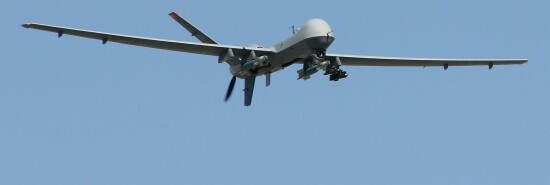
Why did Russia bring down the Reaper drone?
Jon Sweet Mark Toth
Russia‘s downing of a U.S. Air Force Reaper MQ-9 surveillance drone over the Black Sea this week has become a new inflection point in the war in Ukraine.
Russian Defense Minister Sergei Shoigu has presented the pilots involved with awards. Belying video evidence which showed a Russian pilot flew into the drone, he blamed a mix of U.S. arrogance and error for the vehicle’s loss. Regardless, far too much attention is being given to the actual event itself and not enough as to why Russia did what it did.
INTERNATIONAL CRIMINAL COURT ISSUES ARREST WARRANT FOR PUTIN
One possible motive is that Moscow wanted to send a message to Washington. By bringing down the drone, President Vladimir Putin has moved up a rung on the escalation ladder. It’s a ladder he knows that the Biden administration is wary of ascending. The U.S. and NATO have repeatedly stated publicly since the onset of the war that they are acting to avoid direct physical confrontation with Russian forces.
Or perhaps this antic was designed as a show of strength to the Russian people? More importantly, to the nationalists, propagandists, and milbloggers, who have questioned Putin’s resolve in taking on the U.S. and NATO. This show of strength was likely intended to reassure the Russian population that Putin is willing to confront the West.
Then there’s the upcoming visit by Chinese President Xi Jinping to Moscow next week.
The war in Ukraine will be a central topic of discussion, as Putin urgently needs access to Chinese weapons and ammunition to sustain his slow-developing offensive in the Donbas. The downing of the U.S. drone may be intended as a Roman-like “tribute” to Xi, carried out as a quid pro quo retribution for the U.S. downing of the Chinese spy balloon off the coast of South Carolina on Feb. 4.
Beyond messaging, however, Putin understands the drone’s capabilities and its likely mission as Ukraine prepares to launch a much-anticipated Spring counter-offensive. He knows that Crimea is likely one of the key objectives. In turn, this drone downing may have been intended to prevent the U.S. from gathering new intelligence on Russian troop formations and defensive preparations in and around Crimea.
CLICK HERE TO READ MORE FROM THE WASHINGTON EXAMINER
Jonathan Sweet, a retired Army colonel, served 30 years as a military intelligence officer. Follow him on Twitter @JESweet2022.
Mark Toth is a retired economist and entrepreneur who has worked in banking, insurance, publishing, and global commerce. Follow him on Twitter @MCTothSTL.
